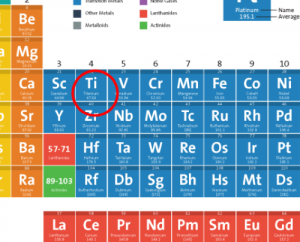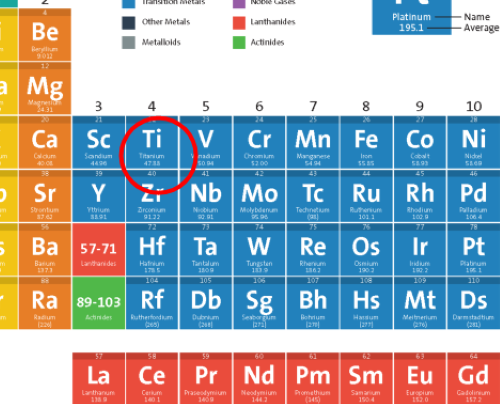
ASTM Standard Specification for Titanium and Titanium Alloy Strip, Sheet, and Plate: Chemical Compositions
| Grade | Products | Compositions |
| 1 | UNS R50250 | Unalloyed titanium |
| 2 | UNS R50400 | Unalloyed titanium |
| 3 | UNS R50550 | Unalloyed titanium |
| 2 | UNS R50700 | Unalloyed titanium |
| 5 | UNS R56400 | 6 % aluminum, 4 % vanadium |
| 6 | UNS R54520 | 5 % aluminum, 2.5 % tin |
| 7 | UNS R52400 | 0.12 to 0.25 % palladium |
| 9 | UNS R56320 | 3.0 % aluminum, 2.5 % vanadium |
| 11 | UNS R52250 | 0.12 to 0.25 % palladium |
| 12 | UNS R53400 | 0.3 % molybdenum, 0.8 % nickel |
| 13 | UNS R53413 | 0.5 % nickel, 0.05 % ruthenium |
| 14 | UNS R53414 | 0.5 % nickel, 0.05 % ruthenium |
| 15 | UNS R53415 | 0.5 % nickel, 0.05 % ruthenium |
| 16 | UNS R52402 | 0.04 to 0.08 % palladium |
| 17 | UNS R52252 | 0.04 to 0.08 % palladium |
| 18 | UNS R56322 | 3 % aluminum, 2.5 % vanadium, and 0.04 to 0.08 % palladium |
| 19 | UNS R58640 | 3 % aluminum, 8 % vanadium, 6 % chromium, 4 % zirconium, and 4 % molybdenum |
| 20 | UNS R58645 | 3 % aluminum, 8 % vanadium, 6 % chromium, 4 % zirconium, 4 % molybdenum, and 0.04 % to 0.08 % palladium |
| 21 | UNS R58210 | 15 % molybdenum, 3 % aluminum, 2.7 % niobium, and 0.25 % silicon |
| 23 | UNS R56407 | 6 % aluminum, 4 % vanadium with extra low interstitial elements, ELI |
| 24 | UNS R56405 | 6 % aluminum, 4 % vanadium, and 0.04 % to 0.08 % palladium |
| 25 | UNS R56403 | 6 % aluminum, 4 % vanadium, 0.3 % to 0.8 % nickel, and 0.04 % to 0.08 % palladium |
| 26 | UNS R52404 | 0.08 to 0.14 % ruthenium |
| 27 | UNS R52254 | 0.08 to 0.14 % ruthenium |
| 28 | UNS R56323 | 3 % aluminum, 2.5 % vanadium, and 0.08 to 0.14 % ruthenium |
| 29 | UNS R56404 | 6 % aluminum, 4 % vanadium with extra low interstitial elements, ELI, and 0.08 to 0.14 % ruthenium |
| 30 | UNS R53530 | 0.3 % cobalt, 0.05 % palladium |
| 31 | UNS R53532 | 0.3 % cobalt, 0.05 % palladium |
| 32 | UNS R55111 | 5 % aluminum, 1 % tin, 1 % zirconium, 1 % vanadium, and 0.8 % molybdenum |
| 33 | UNS R53442 | 0.4 % nickel, 0.015 % palladium, 0.02 5 % ruthenium, and 0.15 % chromium |
| 34 | UNS R53445 | 0.4 % nickel, 0.015 % palladium, 0.025 % ruthenium, and 0.15 % chromium |
| 35 | UNS R56340 | 4.5 % aluminum, 2 % molybdenum, 1.6 % vanadium, 0.5 % iron, and 0.3 % silicon |
| 36 | UNS R58450 | 45 % niobium |
| 37 | UNS R52815 | 1.5 % aluminum |
| 38 | UNS R54250 | 4 % aluminum, 2.5 % vanadium, and 1.5 % iron |
| 39 | UNS R53390 | 0.25 % iron, 0.4 % silicon |
| 40 | UNS R54407 | 3.9 % vanadium, 0.85 % aluminum, 0.25 % iron, and 0.25 % silicon |
Note:
The specified titanium and titanium alloy metals shall meet the chemical composition standards for the following elements: nitrogen, carbon, hydrogen, iron, oxygen, aluminum, vanadium, tin, ruthenium, palladium, cobalt, molybdenum, chromium, nickel, niobium, zirconium, silicon, and titanium.
ASTM Standard Specification for Titanium and Titanium Alloy Strip, Sheet, and Plate: Dimensions Tolerance
| Specified Thickness of Titanium Sheet | Permissible Variations in Thickness, plus and minus |
| 0.146to0.1875in./ 3.71to4.76mm,excl | 0.014in./ 0.36mm |
| 0.131to0.145in./ 3.33to3.68mm | 0.012in./ 0.31mm |
| 0.115to0.130in./ 2.92to3.30mm | 0.010in./ 0.25mm |
| 0.099to0.114in./ 2.51to2.90mm | 0.009in./ 0.23mm |
| 0.084to0.098in./ 2.13to2.49mm | 0.008in./ 0.20mm |
| 0.073to0.083in./ 1.85to2.11mm | 0.007in./ 0.18mm |
| 0.059to0.072in./ 1.50to1.83mm | 0.006in./ 0.15mm |
| 0.041to0.058in./ 1.04to1.47mm | 0.005in./ 0.13mm |
| 0.027to0.040in./ 0.69to1.02mm | 0.004in./ 0.10mm |
| 0.017to0.026in./ 0.43to0.66mm | 0.003in./ 0.08mm |
| 0.008to0.016in./ 0.20to0.41mm | 0.002in./ 0.05mm |
| 0.006to0.007in./ 0.15to0.18mm | 0.0015in./ 0.04mm |
| 0.005in./ 0.13mm | 0.001in./ 0.03mm |
| Specified Width for Thicknesses Under 3⁄16 in. | Permissible Variations in Width |
| 24 to 48 in./ 610 to 1220mm, excl | +1⁄16 in./ +1.60mm, −0 |
| 48 in./ 1220mm and over | +1⁄8 in./ +3.20mm, −0 |
| Specified Length | Permissible Variations in Length |
| Up to 10 ft/ 3m | +1⁄4 in./ +6.35mm, −0 |
| Over 10 to 20 ft/ 3 to 6m | +1⁄2 in./ +12.7mm, −0 |
ASTM Standard Specification for Titanium and Titanium Alloy Strip, Sheet, and Plate: FAQs
1. What Does The ASTM B265 Standard Cover?
ASTM B265 is a standard that specifies requirements for the chemical composition, mechanical properties, and dimensions for various grades of titanium and titanium alloy strips, sheets, and plates.
2. Who Typically Uses The ASTM B265 Standard?
This standard is commonly used by manufacturers, suppliers, and end-users in industries like aerospace, automotive, medical, and marine, where titanium materials are needed for their strength, corrosion resistance, and other unique properties.
3. What Are The Different Grades of Titanium in ASTM B265?
ASTM B265 includes numerous grades, ranging from pure titanium (Grades 1, 2, 3, etc.) to titanium alloys (such as Grade 5, which contains aluminum and vanadium). Each grade has distinct chemical and mechanical properties for specific applications.
4. Are There Any Specific Applications for Certain Grades under ASTM B265?
Yes, for example, Grade 5 titanium is often used in aerospace and marine applications, while Grade 2 is frequently found in chemical processing due to its corrosion resistance.
5. What Is The Significance of ‘Eli’ in Certain Titanium Grades?
‘ELI’ stands for Extra Low Interstitials and is associated with grades like Grade 23. These grades have lower levels of elements like oxygen, carbon, and nitrogen, making them suitable for applications requiring higher ductility and fracture toughness, such as medical implants.
6. How Do ASTM B265 Specifications Affect The Material’s Performance?
The specifications ensure that the materials meet certain minimum standards for mechanical properties like tensile strength and yield strength, which in turn affect their performance in real-world applications.
